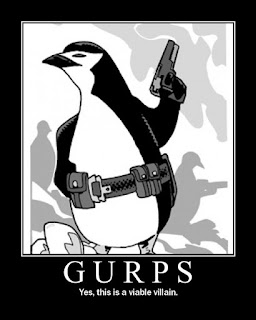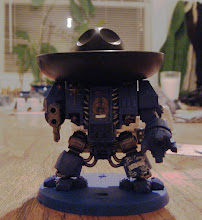Jets that turn into robots, alien
giants, and... Pop stars?!?
Like many a kid who grew up in the 80's
and 90's, I was aware of Robotech. I didn't watch it religiously, but
I caught episodes here and there in reruns. I do remember reading
about it and saw art from it. I always thought it was cool, but
missed out on it. I did watch Macross Plus (yeah, we'll get into the
whole history of Robotech later) and loved it. So, when I stumbled
across the Robotech Role Playing Game, I bought it. At the time, I
was big into anime and Palladium games. A dangerous combination if
there ever was one...
Before I get into the meat of this
review, we do have to talk about what Robotech is. The basics are
that an American company, Harmony Gold, picked up the rights to three
anime series starting with The Super Dimension Fortress Macross. SDF
Macross is one of the big mecha anime and one I've enjoyed, even if
it is from an era long past. Harmony Gold, needing 65 episodes to
meet the syndication standard in America, licensed two additional
series and did some creative editing and changes to make them all
connected. There's a lot of contention about this in the anime
community. Personally, I don't begrudge Harmony Gold for doing what
they did. On the whole, I respect how much of the original Macross
content they were able to show and did a good job of keeping the
characters consistent between the Japanese and American versions. I
see them as parallels, not competitors, and I'm able to appreciate
them for what they are. Of course, the Harmony Gold that exists now
isn't something I really respect, but that's my opinion of the
company and doesn't effect my thoughts on Robotech as a franchise.
Now, let's move on the the Palladium
side of things. Robotech was a very good thing for Palladium, able to
release a game with a built-in fan base. As part of the development,
Palladium created the Mega Damage system, which I discussed in my
Rifts review a while back. It makes a lot of sense that giant robots
would do massive damage and normal weapons wouldn't be able to
scratch them. Unlike Rifts, where I feel like it's a bit
overwhelming, it seems to be a bit more balanced in Robotech.
When you create characters, you're
limited military characters. There's not one non-military character
class in any of the Macross era books. I think we can assume that
they were focused on the giant robots and the characters that
supported them in combat. I think it's a shame, but I can understand
where they were coming from. Nevermind that the Macross series always
involves love triangles and pop stars besides the giant transforming
robots...
The problem with making a game that's
centered around a military organization is that not everyone wants to
play that sort of game. And you should probably have some details
about how the military organization works. Which is lacking in
Robotech. There's NO rank organization chart, and suggests that
pilots start as privates (it doesn't work like that in the US
military or most other militaries). There's no chart or mechanic for
gaining promotions, citations, and demerits, no explanation for how
gaming in a military environment, and the like. Clearly, a bit of a
problem.
When it comes to making your military
character, you can be a Veritech/Valkyrie pilot, a mecha/Destroid
pilot, or one of a variety of support classes like mechanics,
communication specialists, and military specialist, which is really a
Special Forces type character. With all of this, the game is very
much focused on piloting giant robots and blowing things up, and
that's probably what most people want to play. And there's nothing
wrong with that. I do feel like there's a missed opportunity here. I
could see a host of fun games centered around regular jet pilots,
explorers in the ruins of a blasted earth, and the like. Or even just
mercenaries finding ways to make money outside the military.
Moving on to the setting. Unlike the
Sailor Moon RPG, where they gave you a summary of the episodes,
enemies, and monsters, so you could reply the series if you wanted,
Robotech doesn't do that. The author's note (good old Kevin
Siembieda) even says something along the lines of “I imagine most
players will want to play in the post apocalypse Earth, so we have
focused the game there.” Well, yeah, since you didn't include the
stuff they would need to play during the series, they really can't. I
suppose you could, but in the pre-internet world, it would be really
hard to do. I've had ideas about starting a game during the series
about some of the other pilots (or other military types) dealing with
the big battles, and then leading up to the final battle over the
Earth, and then get to the rebuilding of earth. That said, the
rebuilding of Earth is very interesting from a gaming point of view
and does allow for a whole lot of freedom for people, myself
included. I just don't see why they couldn't just give a quick list
of the episodes at least. I mean, they do spend a few pages comparing
the difference between the Robotech universe and the Macross
universe. Why not give a list and a summary of each episode?
Beyond that, the core book gives a few
locations and then some details of the Zentradi Control Zone in South
America, which I guess they expect you center all of your campaigns
around. Speaking of Zentradi, they do give you the option to make
Zentradi characters and enemies. And that's kind of cool. While
there's much to work with it is there. As the core book is set around
the “Macross Saga” part of the show, there's no other enemies for
players, but I'm sure you would find the the later enemies in their
books (Southern Cross and Invid Invasion).
Speaking of the core book, it's only
110 pages long, with over ten pages used for some full page mecha
pictures (not a totally bad thing). To finish out the Macross stuff,
you'd want to pick up the RDF Manual (Book Two) and The Zentradi
(Book Three). Each of these books are 48 pages and cost almost $8 in
1990's dollars. These books also have several wasted pages, used for
a character sheet for each Destroid mecha, absurdly detailed random
hit tables, and other random tables. It feels like a cash grab, to be
honest. They could have tossed these pages in and made a 206 core
book. That would have been cool. Brief aside, I've noticed that
Palladium's licensed products are usually only 110 pages or so. Odd.
Now, these two books do have some good
stuff. The RDF book includes more vehicles and weapons for the RDF,
and maps of the two carriers used with the Macross. There's also a
timeline of events of the Robotech universe, a bunch more information
for the setting, and an expanded random encounter table. If you want
to run a game during the series, you'd want to pick this up, as it
has more NPCs from the show. Some of which were dead by the end.
The Zentradi book is also full of maps,
weapons, and some random tables. For the most part, the book is a
rehash of stuff you've already seen. Again, there's character sheets
with pictures of mecha on them. There are stats for some of the more
important Zentradi that weren't included in the core book.
Since the Macross saga is all I'm
interested in, these are the only books I've picked up. Well, that
and the RDF Accelerated Training Program. This is one of the later
books and gives you a ton of ideas for adventures and can let you run
through the basics of the system.
If you want an episode guide, as well
as some nice pictures, the first Robotech Art Book has a complete
list and summary of every episode in the series. I only found this
out when I stumbled across it at a local used book store. I think
I've discovered the reason why they didn't include this in the rule
book. To get you to spend more money, of course. Clever, clever,
Harmony Gold...
Unfortunately (or is that
fortunately?), Palladium has lost the license to Robotech, after
releasing the Shadow Chronicles expansions (and the whooping failure
of the Tactics game). While they had the license, they did quite a
few books and you can pick up the ones that appeal to you. While they
did skip the Macross series, there's enough there to give you
something to work with. They even released a source book for the
failed Robotech II: The Sentinels, which could be interesting.
Since the game is out of production,
you'll have to do some hunting around on used book markets.
Thankfully, the books go for quite cheap and aren't too hard to find
(and none of your money goes to Harmony Gold). Since I've picked up
the books, I've been thinking about running a game. My idea would be
to start the game during the Defense of Earth battle, then do some
dealing with the aftermath, and then, if the game would last long
enough, you could start dealing with the establishment of colonies on
other worlds. We'll see what happens...
Update: Shortly after I finished
writing this review, I found out that Savage Worlds has the license
for Robotech now. This should be interesting. If I pick it up, you'll
find out soon enough.




















